

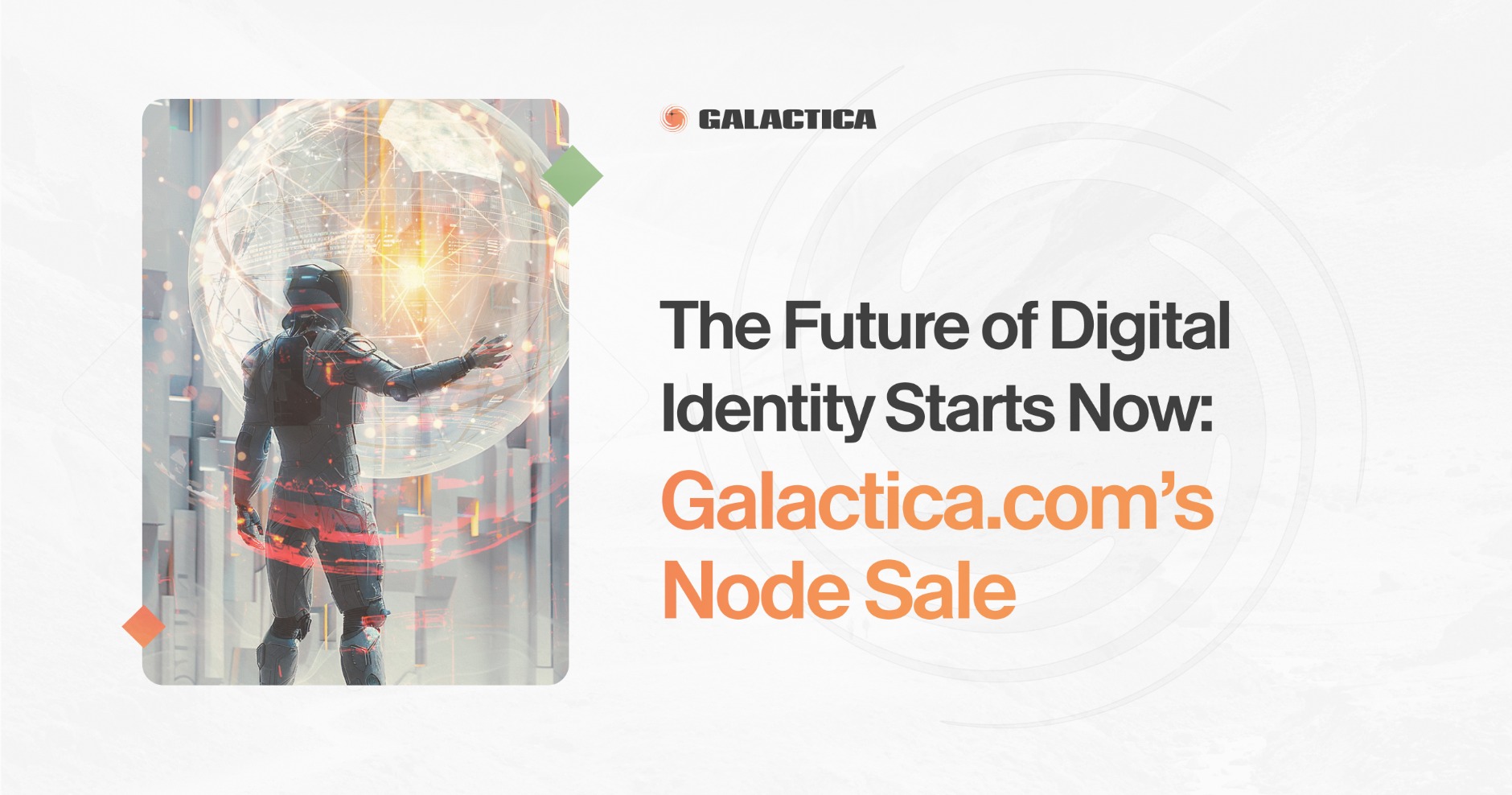
Galactica.com is proud to announce its Node Sale that will hit the market in October through a network of partners and directly through our website and Telegram MiniApp. In this article we will explain in detail what Node Sales are, why should you care and how Galactica node sale is different. We introduce a number of innovations, such as node shards, delineated APY flows and omnichain Telegram-native participation. We will talk more about all of these and much more below.
For those most impatient, you can jump straight to the node sale details here: https://galactica.com/nodesale For those who want to learn more about the concept of Node Sales and get a more gradual introduction into the details of Galactica.com Node Sale, continue reading - we have done our best to make it thoughtful yet not overly technical. Node sales are emerging as a popular alternative to traditional token sales. Unlike token sales, where participants buy liquid tokens with vest schedules, a node sale involves purchasing the right to operate a node within a network. This new fundraising paradigm is meritocratic in nature, allowing users to earn their way down the FDV ladder rather than just buy it through influence. It creates a more level playing field and has other nice properties, such reducing the aggregate sell pressure upon TGE.The idea of a node sale is simple. Users buy a node in a network. Such a node gives them a right to perform work for the network. This work can be technical in nature like running a validator, it can be based on liquidity contributions or it can be social like making content about the network. Each type of activity that generates node rewards has a special vested allocation of tokens that are gradually being released into circulation with more rewards going towards users who have done a better job at performing the tasks.This idea is not new - basically any validator node in PoS networks works according to this principle. Your work is running a node. Your reward is part of token inflation. The measure of quality is the SLA you provide (uptime, blocks missed, etc.). At the same time, node sales generalize this concept to include any type of work that the network can reliably measure.For those OGs of the Galactica.com ecosystem, nodes are very similar to the Galactica Network Citizenship concept we coined years ago. And even though we have decided to rebrand GNCs into nodes, their underlying mechanics are still the same.In what follows, we will provide a deep dive into the concept, benefits and economics of node sales. We will then follow up with the description of the design of Galactica.com node sale. Those feeling like getting down to business in minimal time possible are welcome to check our TLDR one pager. We still, however, recommend reading the whole article in full. We know it's a lot, but it is definitely worth your time if you think about participating.
Chapter I - Introduction to Node Sales
The Node Sale Era: A New Approach to Fundraising
Node sales are emerging as a popular alternative to traditional token sales. Unlike token sales, where participants buy liquid tokens with vest schedules, a node sale involves purchasing the right to operate a node within a network. This new fundraising model is more meritocratic, allowing users to earn their spot based on contributions rather than just financial capital. In a node sale, participants typically buy an NFT or Soulbound Token (SBT), which grants them the license to run a network node. These nodes can perform various tasks, from running validators to generating content, with rewards distributed based on their contributions to the network. This model ensures that value is allocated more fairly to those actively supporting the project's growth.
Why Node Sales are Gaining Traction
A key factor in the popularity of node sales is the alignment of incentives among stakeholders. Project developers secure funding and build a network of committed operators. Node operators gain early access to potentially profitable network participation. Token holders benefit from a more stable and secure network. The overall ecosystem enjoys faster growth, enhanced security, and increased decentralization.
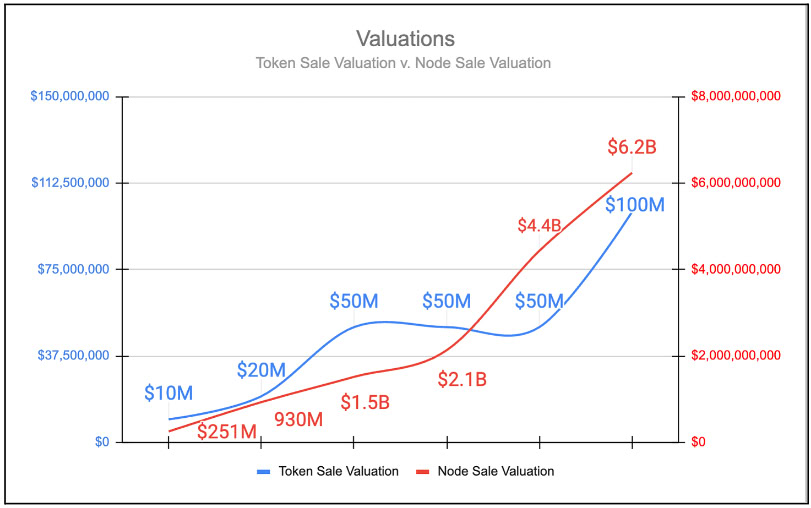
Fig1. Sell Pressure, Token Sale vs. Node Sale
Here are a few more reasons why they have become increasingly popular:
Regulatory Advantages: Node sales are more favorable from a regulatory standpoint than token sales, which can be classified as securities. [1]
Merit-Based Participation: In a node sale, rewards are directly linked to the value participants bring to the network. This starkly contrasts token sales, where early investors may sell at a profit without contributing much to the project's long-term success.
Smoother Token Distribution: Unlike token sales, node sales help mitigate selling pressure by gradually distributing tokens over time, linked to network participation and growth.
Structure of a Node Sale
Node sales generally follow a tiered structure where participants can purchase a spot to operate a network node. The sales are divided into multiple tiers, with earlier tiers offering better pricing and rewards. Key elements of a typical node sale include:
Whitelist Spot: Participants can buy a spot to deploy a node that earns a share of the ecosystem's token supply.
Dynamic Pricing: Nodes are priced in tiers, with each tier offering a limited number of nodes at a higher price than the previous one.
Referral Program: Referrals play a significant role, with participants competing to offer the best referral links and partner allocation.
Node Sale vs. Token Sale
The Node Sale model has several advantages over traditional Token Sales. It allows for lower float improving the overall fundraising capability. Additionally, the referral system typically rewards referred with at least 5% from referred buyers. Selling pressure is also better managed as it is distributed among multiple smaller sellers, reducing the strain during the Token Generation Event (TGE). Some projects, like Hytopia and Aethir, incentivize node operators with increased rewards, such as network fee revenue-sharing bonuses of nearly 50%.
Valuations
As shown in Figure 2.0, the valuation difference from pre-seed to public sale is approximately 10x. For node sales, however, the difference between the first and last-tier valuations can reach nearly 25x. When comparing a public token sale to the last tier node sale, the valuation gap is around 62x. However, if we use a 66% sold-out benchmark, this delta is reduced to approximately 16x. This means that the ROI difference at TGE between Private Investors and Node Sale participants is lower than what is typically seen when comparing pre-seed and public sale. In short, Node Sale participants receive better investment terms as compared to private investors.This signification variation highlights the potential for much greater returns for early node sale participants than those entering at later stages or during a public sale. The tiered structure in node sales provides additional incentives for early buyers, further amplifying the benefits of participating in earlier rounds. The fewer Tiers filled during the Node Sale the more tokens are distributed to fewer participants driving down the FDV at which they have participated, however the implied TGE price (assuming that is close to the last sold Node Tier price) is also lower.
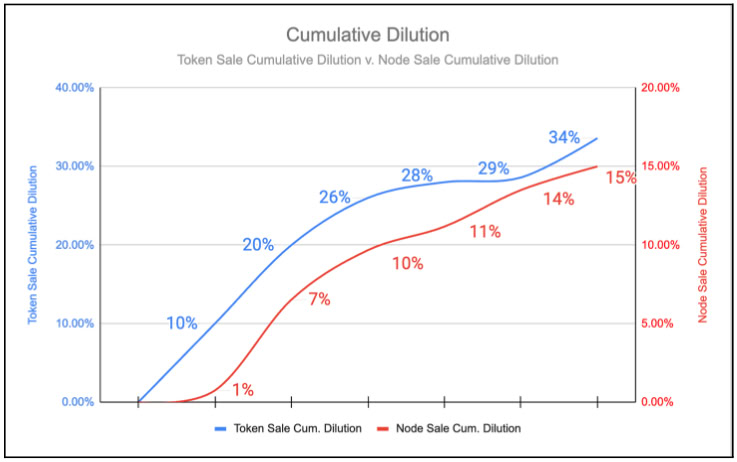
Fig3. Token Sale vs. Node Sale Cumulative Dilution
Raised Amount

Fig4. Cumulative Raised Amounts, Token vs. Node Sales
Figure 4.0 highlights the significant variance in the amounts raised between token and node sales. The graph shows the cumulative raise for a token sale is 12.3 million, while the node sale reached $257 million, resulting in a substantial $244 million difference.Even when applying a 66% sold-out rate, the raise from node sales still mounts to $75 million–an impressive 6x more than traditional token sales. This demonstrates the powerful fundraising capabilities of node sales, allowing projects to generate far better capital while engaging a broader base of investors.
Investor Returns
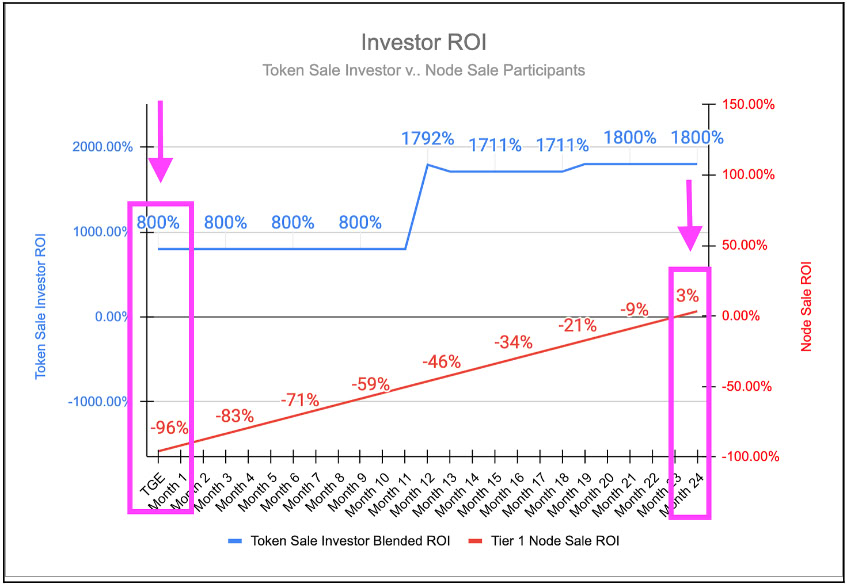
Fig5. Investor ROI for Token vs. Node Sale Participants
Figure 5.0 underscores the key difference between token sales and node sales: no single entity can dump tokens on buyers. According to the investor RIO chart, token sale investors see a significant return of 840% at the Token Generation Event (TGE). Tier 1 node runners only recoup around 4% of their principal, breaking even over 24 months.This distinction highlights node sales' slower, more gradual return profile, which favors long-term sustainability over short-term speculation, making it a more stable investment option for those seeking consistent rewards.
Sell Pressure
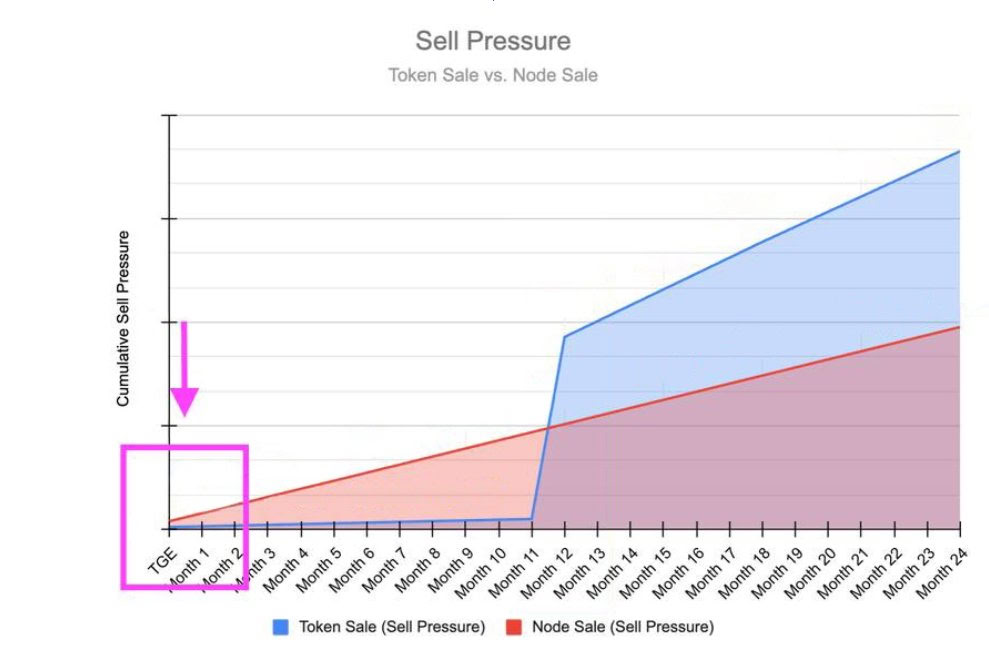
Fig6. Token vs. Node Sale: Sell Pressure pt1
Figure 6.0 reveals that the release schedule for node sales emits 3x more tokens than a traditional token sale. However, when factoring in ROI data, $423K (94%) of the $450K is investor profit at the Token Generation Event (TGE). In contrast, the sell pressure from node sales amounts to 1.5 million, generated by 100,000 nodes with only $16 worth of sell pressure per node.This comparison illustrates that while more tokens are released through node sales, the individual sell pressure is significantly lower, distributing the impact more evenly across a larger base of investors.

Fig7. Token v.s. Node Sale: Sell Pressure pt2
Figure 7.0 shows that at the one-year mark, the dynamic shifts as private investors receive the first tranche of their vested tokens. This creates a noticeable increase in selling pressure from token sale participants, which is 1.5x greater than the node sale.The difference highlights how the staggered release of tokens in node sales helps mitigate sudden sell-offs, maintaining market stability compared to the larger, more immediate pressure created by token sales. This structure makes node sales more attractive for long-term project sustainability.
Thanks to @0xkapital_k for comparing Node Sale and Token Sale in his article.
Benefits of Node Sales for Participants
Meritocracy in Distribution: Node sales ensure that rewards are distributed based on merit. Those who actively contribute–whether through technical skills or community engagement–are rewarded with lower Fully Diluted Valuations (FDVs) and other benefits.
Dynamic Rewards Structures: The reward distribution in a node sale can change over time, reflecting the project's evolving needs. Furthermore, node holders can be vital part of the governance of the protocol. This flexibility ensures that contributors remain incentivized to continue supporting the network. Consider for example Galactica's Governance. [2] [3]
Long-Term Engagement:Node Sales encourages long-term participation by rewarding contributors with ongoing tokens tied to network performance.
The Evolution of Fundraising: Why Node Sales are the Future
As Web3 continues to evolve, the node sale model is becoming a new fundraising meta, combining the elements of both airdrops and VC funding. This approach offers several key benefits for both projects and participants:
Flexible Capital Distribution: Projects can dynamically adjust reward structures based on network participation, ensuring that contributions are continually incentivized.
Soul-Centric DeFi: Contributions to one project can enhance a participation's reputation across the Web3 ecosystem, unlocking new opportunities in other projects.
Merit-Based Access: Participants are rewarded for their financial investment and the real value they bring to the network, creating a more inclusive and fair fundraising environment.
Case Studies: Notable Past Node Sales
Several projects have successfully raised significant amounts of capital through node sales. Notable examples include:
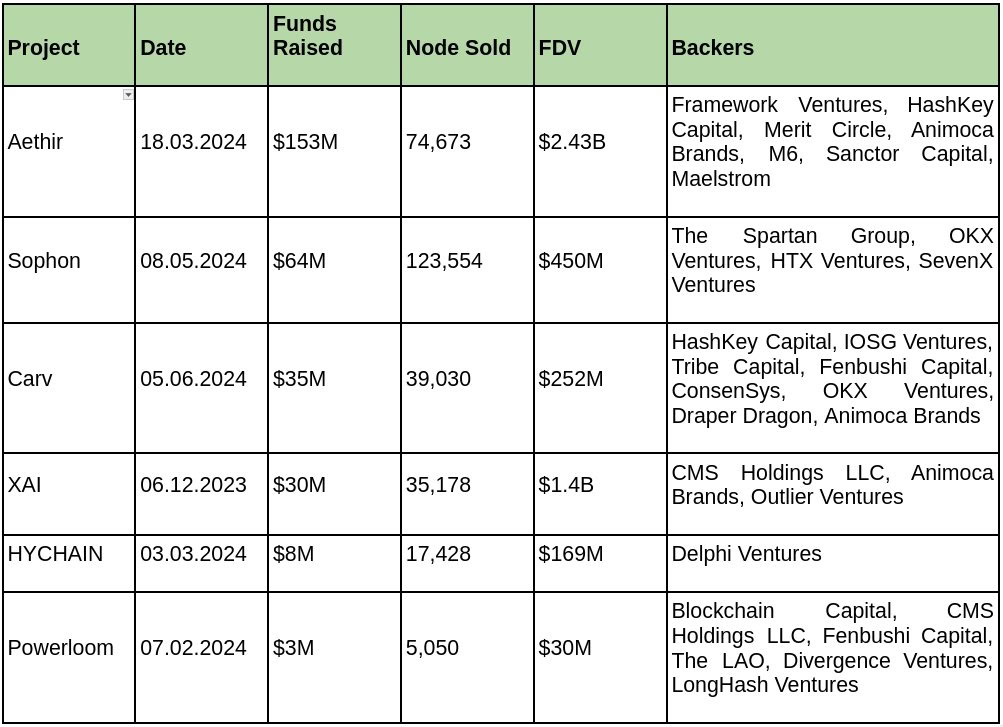
Table 1. Analysis of past Node Sales
Aethir: Raised $153 million by selling 74,673 nodes, achieving a $2.43 billion FDV [4]. Major backers included Framework Ventures, Hashkey Capital, and Merit Circle.
Sophon: Raised $64 million through 123,554 node sales, with an FDV of $450 million [5]. Key backers include The Spartan Group and OKX Ventures.
Carv: Raised $35 million with over 39,000 nodes sold, supported by Hashkey Capital, IOSG Ventures, and Fenbushi Capital [6].
These projects highlight the growing interest in node sales. Investors see the potential for higher returns and more equitable capital distribution than traditional token sales.
The Galactica.com Node Sale
The Galactica Node Distribution (GND) is a mechanism by which participants can contribute to the network and receive a digital certificate that grants access to the GNET coin. GNET enables holders to perform specific tasks, determining their ranking relative to other eligible participants in the GNET inflation reward distribution of the Galactica.com blockchain protocol. Only those holding these digital certificates can compete for inflation rewards within the network.Two certificates are available:
Galactica Citizen Node (GCN) - a full Galactica Node.
Galactica Node Shard (GNS) - a part of a Galactica Node.
These certificates differ in several key aspects, including their price, activation process, functionality, the types of tasks participants can complete, and the specific reward pools they are eligible to access. Each type of certificate offers distinct opportunities and benefits within the Galactica ecosystem.
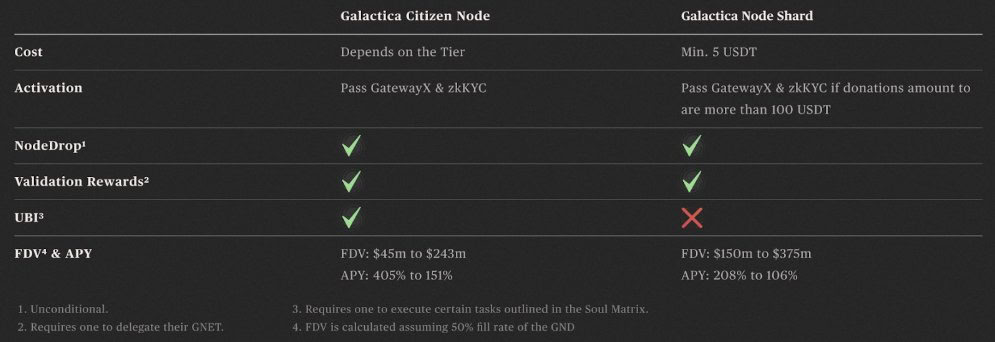
Fig8: GCN vs. GNS Summary
Distribution
The distribution of GCNs and GNSs will take place through Galactica Node Sale Telegram App as well as through a number of partner platforms. Galactica team is proud to introduce the first of its kind Telegram App for distribution of nodes. You can read more about it right here: https://galactica.com/nodesale
Users will only be able to purchase GNSs through our TMA. GCNs will be available on TMA as well as elsewhere on partner platforms. The exact timeline will be announced soon.
Stay tuned.
Tokenomics
The highlighted fields in Figure 9 outline the rewards for Galactica Node Distribution participants. The vesting schedule for the Node Drop is linear while that of the UBI and Validation Rewards is not (see Figures 10 and 11). In other words, over 33% of the Inflation (incl. UBI and Validation Rewards) is released within the first 2 years and over 55% over the first 4 years.
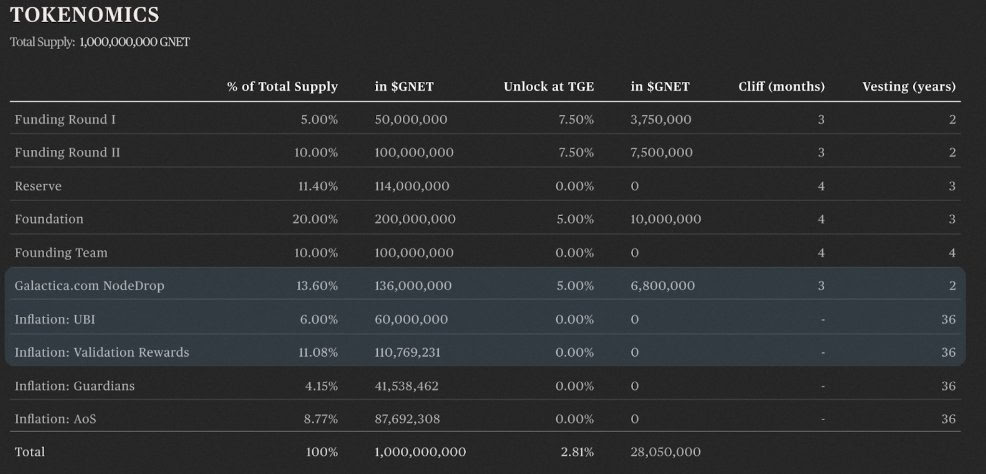
Fig9: GNET Tokenomics
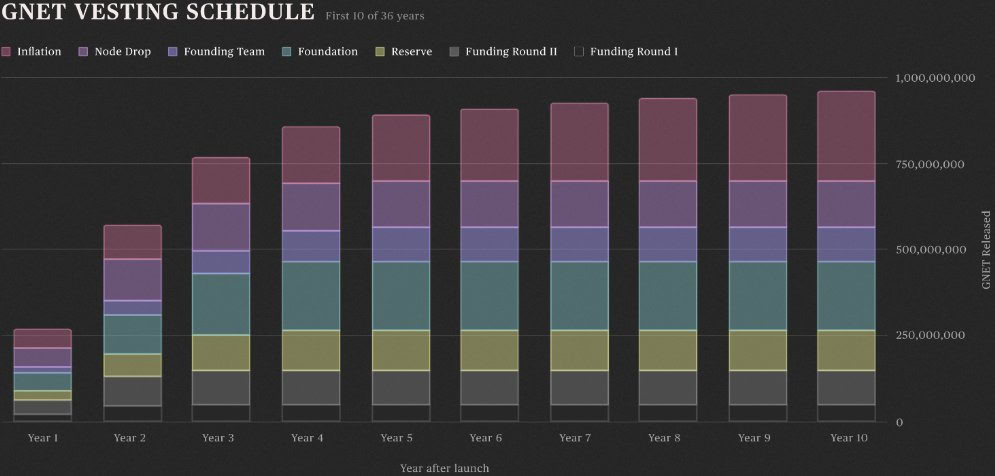
Fig10: GNET Vesting Schedule
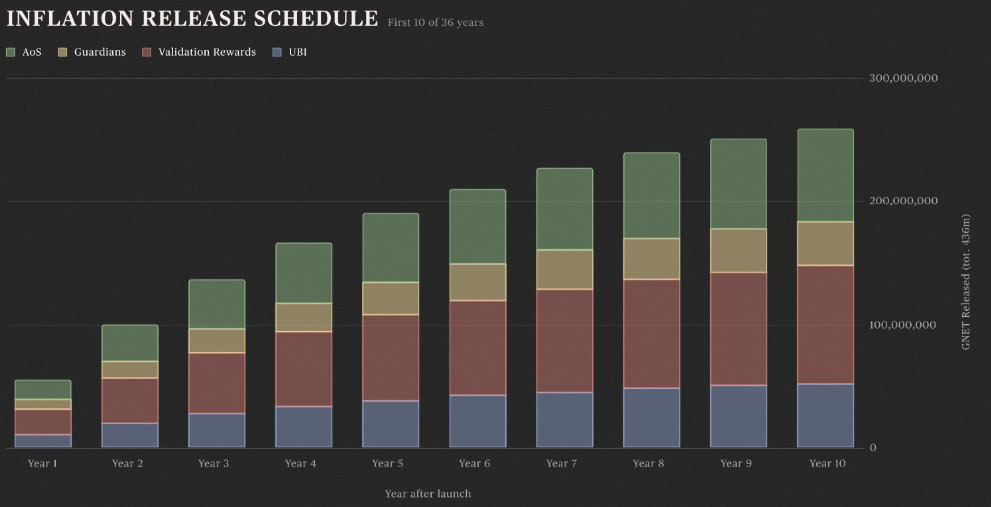
Fig11: Inflation Release Schedule
Rewards Structure
As noted in Figure 9 a total of 30.68% of the GNET total supply is dedicated to Galactica Node Distribution participants*. The Galactica node sale operates differently from traditional models, incorporating several key components.
First, as long as you have donated during the GND campaign, you are granted an SBT that conditionally (see Figure 8) provides access to the Node Drop in the tokenomics. This ensures participation without additional steps beyond the initial donation.
To earn Galactica's Universal Basic Income (UBI), you must hold a GCN and execute specific tasks outlined in the Soul Matrix. This system makes rewards merit-based, requiring active involvement in the ecosystem.
To be eligible for Validation Rewards, the Node Drop rewards and the UBI stemming from the tasks completed from the Soul Matrix need to be staked with validator(s) of your choice. This process helps secure the network while rewarding participants for their contributions.
Depending on whether one holds a GCN or GNS the potential rewards differ:
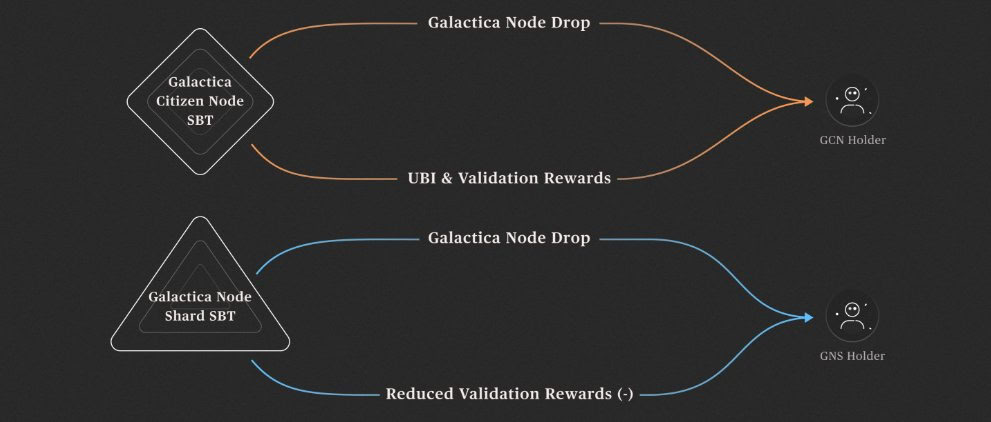
Fig12: GCN vs. GNS Rewards
*Note that GCN holders will be able to apply for the Academy of Sciences (AoS) [7] and potentially earn another 8.77% of the total GNET supply.







